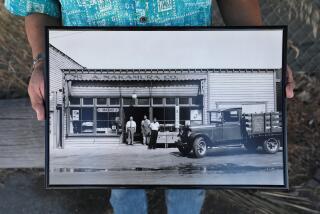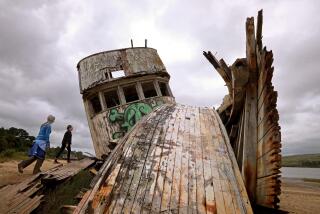Lighthouse Offers a Beacon on the Past in San Pedro
- Share via
Nineteenth century sea captains gratefully followed its piercing ray through inky nights to find safe harbor in Los Angeles and to avoid foundering on the rocky coastline.
The ornate wooden Point Fermin Lighthouse in San Pedro, whose beacon was extinguished decades ago, now beckons those who want a peek at a forgotten profession and a quaint lifestyle.
“So much of our world of the past is getting lost, and many of our children don’t understand what people did for humanity in things like lighthouses,” said Martha Austin McKinzie, a preservationist whose relatives were the last lighthouse keepers to live in the building atop the San Pedro palisade.
“This lighthouse is a symbol of people caring about other people,” she said.
From the windows of a special “watch room” just below the illuminated Fresnel lens, lighthouse keepers would spend long hours peering at the ocean to spot ships in trouble and send help.
This month marks the 130th birthday of the well-preserved four-story Victorian structure.
The most important job of lighthouse keepers was to keep the beacon lighted, and that was no small task.
Until electricity came to Point Fermin in the 1920s, keepers had to carefully tend to such tasks as ensuring that the oil reservoir didn’t run empty, keeping the wick trimmed and checking that the flame didn’t sputter out overnight.
“We have global positioning satellites now, and people don’t even think of how early mariners found the coast and made this a shipping port,” said McKinzie, president of the Point Fermin Lighthouse Society.
Today, the adjacent Los Angeles Harbor is the nation’s busiest container port.
The lighthouse, the first in the Los Angeles region, began shining its lamp on Dec. 15, 1874, to service the growing harbor founded in the 1850s.
The tower and the attached four-bedroom house, which are open to visitors Tuesdays through Sundays from 1 to 4 p.m., have weathered the years well. “I’m thrilled that almost all of it is original,” said Kristen Childs, a historic-site curator for the Los Angeles Department of Recreation and Parks. The agency oversees the building for the U.S. Coast Guard, which owns it.
Though it was in relatively good shape, the aging structure was nearly bulldozed in 1972. Community activists saved it.
The building underwent a $2.6-million face-lift in 2002 and 2003 that involved new wiring, plumbing, landscaping and paint. A year ago, it opened to the public for the first time.
McKinzie, 57, still has the logbook in which decades of keepers noted in florid penmanship when they turned the lantern on and off, filled the oil depot or spotted a ship. The logbook was passed down to McKinzie by her grandparents.
Her father’s parents, Will and Martha Austin, were career lighthouse keepers who worked first at Point Arena in Mendocino County, beginning about 1901, then at Point Conception in Santa Barbara County. They tended Point Fermin from 1917 to 1925, when they both died. Sometime around the end of their tenure, an electric lamp was installed.
McKinzie said two of her aunts “flipped on the light switch every night for a couple of years,” until the Coast Guard automated the operation.
The light was permanently extinguished within hours after Pearl Harbor was bombed, Childs said. Because of fear that Japanese submarines would attack, Pacific Coast lighthouses went dark.
“During the war, the military took out the light and put an ugly box on top, which they used as a lookout tower to watch for submarines,” McKinzie said. Later, a navigational beam placed atop a pole a few yards away took over the lighthouse’s function.
In recent years, the lighthouse has served as the private residence of supervisors of Point Fermin Park, a 37-acre expanse of well-tended gardens, tree-shaded lawns and pergolas.
Today, only a few U.S. lighthouses have keepers, McKinzie said. The lighthouse society is planning to turn the Point Fermin Lighthouse into a museum with artifacts and period furniture from its active years.
“The fact that this has survived 130 years says to me how much people care about their past,” Childs said. “The only thing that keeps these buildings up is that people care about them.”
More to Read
Sign up for The Wild
We’ll help you find the best places to hike, bike and run, as well as the perfect silent spots for meditation and yoga.
You may occasionally receive promotional content from the Los Angeles Times.






